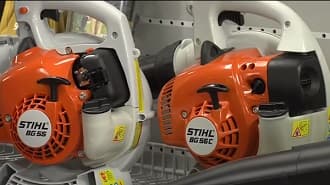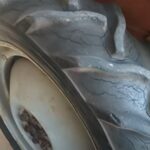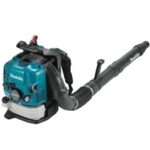As an Amazon Associate, this site earns commissions from qualifying purchases. For more information click here.
Is your Stihl leaf blower losing power? Did it suddenly stop blowing like it used to, or is it happening slowly? When this occurs there is a problem with the engine or other parts. This guide walks you through the most likely causes and what you can do to fix them.
The most common reason Stihl leaf blowers cannot blow hard enough is a clogged up impeller, a flooded engine or defective spark plug. If debris has blocked the blower tubes, its ability to blow air will be limited.
Flooded Engine
A flooded engine means there is too much fuel, making ignition impossible. This can cause a lot of potential problems including reduced blowing capacity. There are many reasons why an engine gets flooded, so the solution depends on the cause.
How to Fix
Adjust the fuel to air mixture. Because a flooded engine has excessive fuel, a simple solution is to start the leaf blower and let it burn the fuel.
You may see some smoke or smell powerful gas. That is to be expected. Wait a few minutes until the extraneous fuel is gone. When the engine is running normally, try the leaf blower again.
Replace the fuel. If there is too much fuel and it is all over the engine, it is best to replace it. Drain the fuel and clean the engine. Add new fuel and make sure that the fuel and air mixture is correct this time.
Clean the air filter. If the filter is dirty or damaged, that could be the reason why not enough air gets into the fuel mix. Remove the filter and wipe it clean. If the filter is really dirty, use soapy water to remove the grime. This can happen if you try using a leaf blower on gravel or other large areas.
Damaged Fan
Leaf blowers have a fan connected to the crankshaft. It circulates air as the blower operates. It is possible for dirt and debris to block or damage the fins. If this happens the leaf blower might have a hard time blowing or lose power altogether.
How to Fix
Turn the leaf blower off and locate the fan. Its location may vary so check your Stihl manual for its exact location.
Once you find the fan, check for signs of damage. If one or more of the fins is broken, you have to take it for repairs or check if replacement parts are available.
If the fan is still intact, wipe the dirt off and try the leaf blower again. Note that with many leaf blowers, fan and impeller are used interchangeably.
Loose Nuts
Leaf blowers have several screws and nuts, but these nuts are those which connect the fan or impeller onto the crankshaft.
Due to wear and tear, debris or mishandling, the nut might come loose. If that happens the fan might come off the crankshaft. The crankshaft will keep running but without the fan or impeller, air circulation is impossible. This is going to prevent a leaf blower from blowing at maximum level.
How to Fix
The only way to repair this is to fasten the nuts. Turn the leaf blower off and remove the spark plug. Next, look for the crankshaft in the engine. If the fan came loose, you will see it immediately. Put the nut back and reattach the fan.
Before you do so, do check the fan for indications of damage or dirt. Put the fan back on. Before you reinstall the spark plug, clean it too. Carbon deposits build up over time and cleaning or replacing is something you should consider.

Missing or Damaged Tubes
In most leaf blowers, the tubes determines where air circulates when you use it. With other Stihl blowers the tubes might funnel the airflow into a nozzle to boost performance. There is nothing wrong with this unless the tubes gets damaged.
How to Fix
Before you attempt to replace the tubes, check the leaf blower settings first. Some of these blowers let you change the air flow so the blower functions like a vacuum.
If the blower has been configured this way that could be the reason why the Stihl is not blowing hard. Change the setting first and see if blowing capacity improves. If not, you can start checking the tubes.
First you need to consult your owner’s manual and find out how its tubes work. Next check if there are any damaged tubes. If yes they have to be replaced. These tubes cannot be repaired.
Broken Impeller
The impeller refers to the fan blade that pulls air into the system and spreads it out in the tube. If you look inside a leaf blower engine you will see the impeller connected to the crankshaft.
When you turn on a leaf blower, the crankshaft rotates. Because the impeller is attached to the crankshaft, it turns as well and pulls air in the leaf blower. Because of the role it plays, the impeller is one of the first places you should look at if your leaf blower is not blowing as hard as it should.
How to Fix
Turn your leaf blower off. Remove the spark plug and lift the engine cover. You can use something like the Ram-Pro Inline Spark Tester to check if the plug is still working.
Depending on the leaf blower design, you might have to remove other parts to see the crankshaft and impeller. Refer to your Stihl manual as a guide.
Remember the order you removed the parts so you can put it back together. The impeller should be connected to the crankshaft. You should be able to tell if it is dirty or broken.
If there is damage the only option is to replace it. If there is only dirt or a loose nut, you can fix that. Clean the impeller and tighten the nut.
Defective Spark Plug
The spark plug is what makes ignition possible, so if they are damaged, dirty or worn out your leaf blower will not run properly. The engine might flood and this will affect the way the device blows.
How to Fix`
There are two options, clean or replace the spark plug. If the plug is a few years old and covered with carbon deposit, fuel, dirt, etc. get a new one. Remove the spark plug and install a new one. The Hayskill replacement kit includes compatible spark plugs for the Stihl BG45, BG55, BG65 and BG85.
Test the leaf blower and it should work.
As long as the spark plug is compatible with the leaf blower there should be no problems. Now if it still does not work, the engine could be flooded. Follow the guidelines given earlier to fix engine flooding.
This fix will only work if the spark plug is precisely like the current one. You can find more information about your leaf blower spark plug in the manufacturer website.
Fuel is Old
Stihl leaf blowers cannot run on months old fuel. If the fuel has been sitting in the tank for 30 days or longer, replace it.
The older gas gets, the faster it dissipates. It leaves behind a thick gummy substance that can spread all over the engine. This substance cannot be used as fuel. Worse it clogs up the carburetor, filter, spark plugs and other parts. This bottleneck is going to prevent the leaf blower from functioning properly.
How to Fix
Replace the old fuel. Open the fuel tank and let the liquid flow out. Make sure you have a pan ready to catch all the fuel.
Once the tank is empty, give it a good cleaning. Chances are there is residue stuck everywhere. Clean not just the tank but also the carburetor and the rest of the engine. There are a lot of cleaning solutions available designed for this.
Most leaf blower run on regular unleaded gas. The rating should be 87 octane and no more than 10% ethanol. Some leaf blowers state that 87 octane is the minimum requirement, but others prefer exactly 87 octane. If you are not sure, check your owner’s manual.

I love the outdoors and all the tools for maintaining gardens, yards and lawns. The only thing I am more passionate about is sharing what I know about garden and outdoor equipment.


